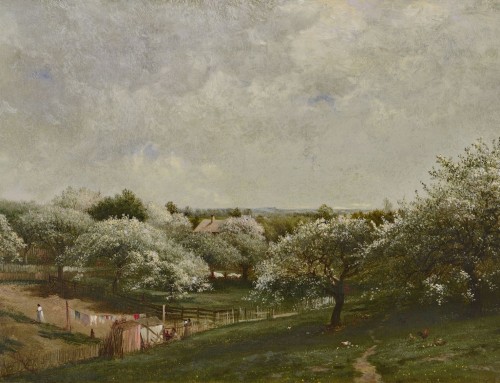Project Description
Henry Roderick Newman
Philae from the Island of Biggeh
1894
Watercolor on Paper
17 1/2″ x 28 1/4″ in
Over the years a number of crisply detailed Egyptian watercolors by the American expatriate Henry Roderick Newman (1843-1917) have passed through the gallery, and we currently have two such works. Dated 1894Philae from the Island of Biggeh encompasses the Ptolemaic temple complex in southern Egypt. Philae was revered in ancient days as one of the burying places of the God Osiris. Dated only “March 5″ (see below), Abu Simbel portrays the third and fourth colossal figures of the powerful New Kingdom Pharaoh Ramesses II, rock-cut in the 13th dynasty at his temple in Aswan, situated in lower Nubia (now The Sudan). An intriguing aspect of the works is that they both depict sites that no longer exist as Newman showed them. Both were moved by UNESCO in the 1970s as part of the Nubia Rescue Campaign, when the construction of the Aswan High Dam threatened to submerge them. The buildings of Philae were relocated to the nearby island of Agilkia, while those of Abu Simbel were re-erected on an artificial hill set high above the Aswan Dam reservoir.
Newman and his English wife Mary, whose home was in Florence, spent their winters in Egypt from the mid-1880s through the mid-1900s, residing in a large dahabeah (houseboat), which became a familiar sight to the many tourists who traveled up the Nile to visit Philae, the “Pearl of Egypt.” Indeed, Newman became so associated with this locale that he was given the nickname of “Philae Newman” (other Philae images by Newman are in the Metropolitan Museum of Art and the Museum of Fine Arts, Boston). Portraying the scene in our watercolor from Biggeh, southeast of Philae, Newman painted the lush vegetation in the foreground in the tight and elaborate detail that recalled his earlier connection with the Association for the Advancement of Truth in Art, the group of American artists who followed the English theorist John Ruskin in a belief that nature should be studied directly. (Ruskin became a patron and mentor to Newman after acquiring one of Newman’s Venetian watercolors in 1877.) The view in our watercolor is across the water, showing the Nile at a low ebb (probably in February or March) and looking toward Philae’s Quay Wall, just beyond the West Colonnade, which enclosed the island’s Great Nilometer. Before us is the massive First Pylon of the Temple of Isis, while visible on the Pylon’s façade is the Greek Pharaoh Ptolemy Neos Dionysos (father of famed Cleopatra VII), grasping his enemies by the hair and preparing to strike them dead, while the goddess Isis watches approvingly. Other figures of Hathor, goddess of love, and Horus, the falcon, are also visible, while the smaller Second Pylon and Hadrian’s Gateway are beyond. Newman omitted the steamboats and houseboats that clogged the Nile in the 1890s, but a sense of the time may be seen in the waterline on the buildings, evidence of the flooding due to an earlier dam at Aswan, and in the tiny figures fishing below the temple complex; this activity was prohibited in the days of ancient Egypt, when only priests were allowed within the sacred grove and local people were asked to whisper while religious rites were underway. The painting still bears its original frame, a style Newman used frequently for his Egyptian works, featuring stylized, intertwined flowers in the decorative mode of the English aesthetic movement.
Henry Roderick Newman, “Abu Simbel,” 1890s, watercolor and pencil on paper, 25-3/4 x 16-1/2 inches
In Abu Simbel the two immense figures of the bare-chested deified pharaoh (each 65 feet in height) are seen obliquely from below, drawing our attention to the look of utter serenity transcending worldly concerns that conveyed Ramesses’s perpetuity. The vertical format amplifies the size and directional focus in the work, while Newman used watercolor washes skillfully to note the weathering of the stone. At the right is what was left of the sanddrift that once reached up to the heads of the statues, while directly before us in the left foreground is the head (with Nemes headdress) of the second figure, which fell from the statue when an earthquake occurred in the 31st year of Ramesses’s reign. The head was left in this position when the statues were moved, but the sand drift and rubble seen in Newman’s image are no longer present.
Henry Roderick, Newman, “Philae from the Island of Biggeh,” corner of frame
Adept at identifying the pulse of his era, Newman, in his views of Egyptian relics, answered to the seemingly insatiable craving for things Egyptian that swept through America and Europe at the turn of the twentieth century, while his images now have a distinct place in the Egyptomania that is still with us–note the three!!! Egyptian exhibitions being held right now just in New York: Tutankhamun’s Funeral at the Metropolitan Museum of Art;Tutankhamun and the Golden Age of the Pharaohs at Discovery Times Square; and Body Parts: Ancient Egyptian Fragments and Amulets at the Brooklyn Museum. In addition, concurrent with the opening of its new Egyptian galleries, the Nelson-Atkins Museum has an exhibition on view from March 6 to July 18, 2010 entitled Exploring Egypt: 19th Century Expeditionary Photography. These early photographs provided the western world with its first visions of ancient mysteries as they were excavated, “fulfilling the vicarious desires of the armchair traveler back home.” Newman’s watercolors provided a similar experience for his patrons.






